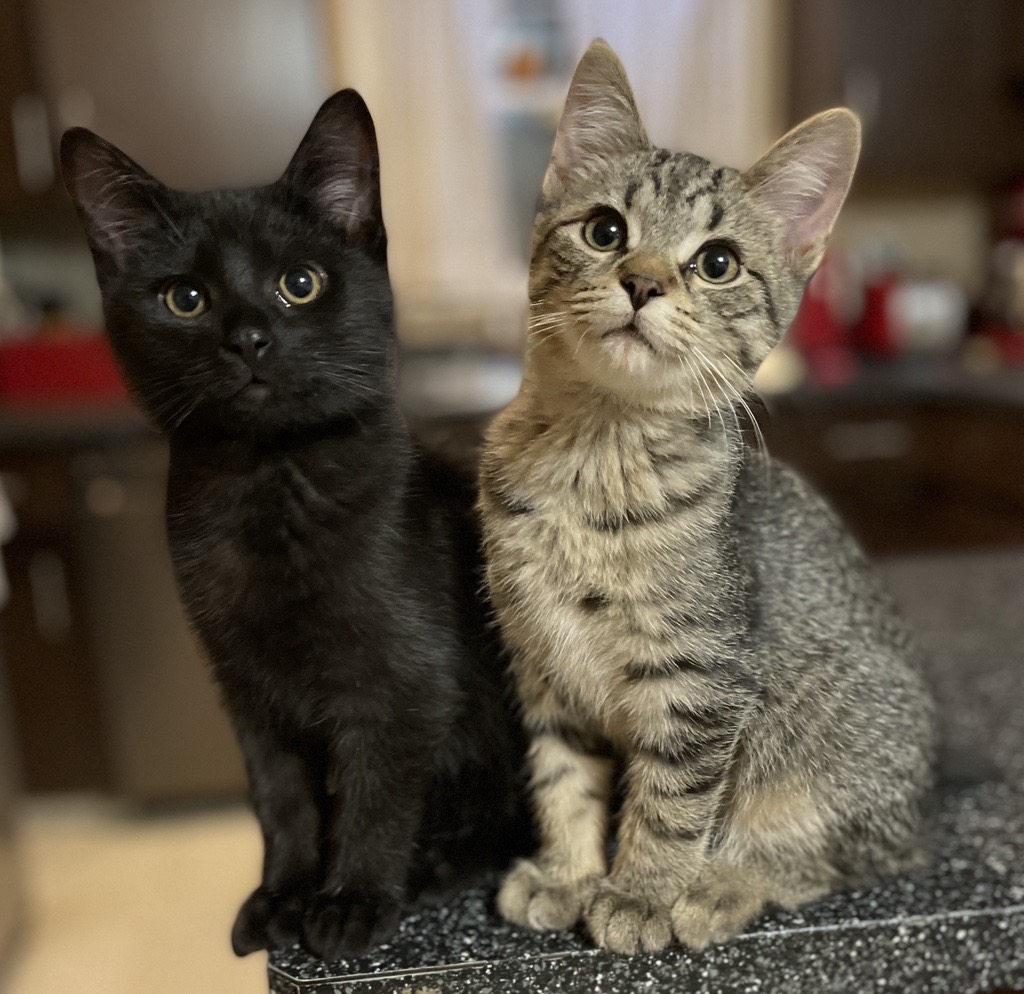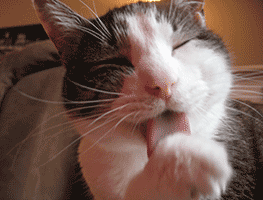Countertop Jumping in Cats
Is your cat jumping up onto your kitchen countertops or other high surfaces where you don’t want them to be? There are some spots in your home where it may be unhygienic or even downright hazardous for your cat, but they’ll need some help understanding the boundaries you set.
 Most cats enjoy being in high places to keep an eye on the world around and below them, and this often includes kitchen countertops. Although some cat owners don’t mind this behavior and allow their feline friends to explore their counters, there are some owners who find this behavior to be bothersome, unhygienic, or worry-inducing. It is important to remember that your cat will not innately understand where you do and don’t want them to be, as jumping up on spaces high off the ground is a normal and natural behavior for them. Modifying this behavior is possible but takes work and consistency.
Most cats enjoy being in high places to keep an eye on the world around and below them, and this often includes kitchen countertops. Although some cat owners don’t mind this behavior and allow their feline friends to explore their counters, there are some owners who find this behavior to be bothersome, unhygienic, or worry-inducing. It is important to remember that your cat will not innately understand where you do and don’t want them to be, as jumping up on spaces high off the ground is a normal and natural behavior for them. Modifying this behavior is possible but takes work and consistency.
Whether you allow this behavior or not, there are several potential hazards to both cats and humans if your cat likes to prowl on kitchen counters. They could accidentally step onto a hot stove, paw at knives or sharp utensils, ingest chemical residue from cleaning products, or consume food that may upset their stomach. You could also be at risk for sanitary issues, as cats scratch around in their litter and often have residual crystals in their paws which could lead to bacteria contaminating any food you’re prepping on that surface.
Why does my cat like being on the countertop?
Not only do cats love heights, but your counters also have many qualities that encourage and even reinforce the behavior. The kitchen is a social place where you, their favorite human, spend a lot of time. If they’re looking for attention from you, they’re sure to get some as soon as they leap up to investigate what you’re working on. The kitchen also smells good and is intriguing to curious cats, and they may even be rewarded for jumping up if they find a little food to snack on once they get there. Some cats are also interested in running water and may enjoy going into the sink if there is a drip. No matter what is piquing their interest, there are ways you can deter them from the habit and ensure your kitchen stays a clean and safe space.
Ways to reduce your cat’s desire to jump on countertops
Management | Start by making your counter unrewarding by keeping your countertop clean. Remove all food, crumbs, plants, mail baskets, or anything else your cat may be drawn to. Without realizing it, you may be leaving “rewards” on your counter, and if your cat is rewarded for jumping on the counter, the behavior will continue.
If your cat has the opportunity to practice jumping on the countertop while you are out of the home, the behavior will take much longer to modify. You may need to close the doors leading to your kitchen or create a cat-safe space in a bedroom so they don’t have access to the kitchen while you are not home. If you do choose to place your cat in a separate bedroom when you’re away, you will need to provide them with a scratching post, comfortable bed, food, water, toys, litter box, and enrichment items.
More Playtime/Enrichment | In some situations, your cat may be bored and will keep themselves occupied by exploring the countertops. If there is a pattern of your cat jumping on the countertop and you entering the kitchen to get them down, they will quickly learn this is an easy way to get your attention. Try adding more scheduled, daily playtime with your cat. You may try using a cat charmer, tossing their favorite small toys to chase, or giving them extra enrichment throughout the day.
If your cat is interested in the countertops due to leaking or running water from the faucet, try providing them with their own running water bowl/fountain in an appropriate spot on the floor and ensure your faucet gets fixed.
Provide More Cat Furniture and Alternative Perches | Does your cat have enough places in the home where they can be high off the ground? This could include pet-specific items like a cat tree or climber, or it could be as simple as a mantel, a window ledge, or a comfy spot atop the back of the couch. If they don’t already have multiple high-perspective options, you may want to invest in a climbing tree or cat tower. If that’s not in your budget, take a closer look at how your furniture is arranged. Are you able to move a small table underneath a window so your cat can hop up and look out? Could you move a sturdy shelf closer to the mantel for your cat to safely jump up onto? When adding or rearranging items in your home, you can place treats at the top as a rewarding surprise to encourage and reinforce that this spot was meant just for them.
If your cat already has cat furniture that provides them with high views and they continue to counter surf, you may want to try providing them with acceptable alternatives inside the kitchen. This could be a cat tree that you move into the kitchen, a chair, or a bar stool. No matter what you choose, make sure that spot is extra appealing, if not irresistible to your cat. When you see them go to that designated place, be sure to heavily reinforce them with praise, petting, and their favorite treats. Keep in mind, all cats are individuals and may find different things reinforcing, so stick with what your cat likes best.
If your cat is highly interested in a window that’s only accessible from the kitchen counter, you’ll need to find ways to make a different window more appealing. Start on the inside by ensuring your cat has easy access and a comfortable spot to rest while they watch the world pass by. Slide a cat tree or table to the new window, place a bed in the sill if it’s large enough, or buy a perch that attaches directly to the window itself. Next, find ways to add extra interest outside the window by adding bird feeders, plants that attract pollinators, or other devices meant to attract critters. On that note, you’ll want to ensure none of these items are visible from the kitchen window, as we want that counter spot to be as uninteresting as possible for them.
Redirection | If your cat does jump up on the counter, calmly and gently pick them up and guide them to a more appropriate place with food or toys. Be sure to continue to reinforce those approved spaces with treats and little bits of canned cat food so they become more desirable than your countertops.
Deterrents | If you’ve tried all of the above plans routinely and consistently over time and they still did not work, you may consider using deterrents as a last resort while continuing to use the management plans above. When determining what deterrents to use, be sure they are not going to cause major stress or harm to your cat. Cats generally don’t respond well to punishment and don’t make the connection that their own behavior caused a frightening thing to happen. Punishment often causes stress in cats and can provoke aggression, creating a whole new problem for you to solve. Frightening deterrents can also harm your relationship with your cat and erode their trust.
We do not recommend coin-shaking cans, water spray bottles, sprays that emit a burst of air, nor scat mats that deliver a static shock or contain spikes.
If you plan to use deterrents, the following products are less stressful while still making the countertop an unpleasant place for them to be.
- Sticky Tape: Using double-sided tape may deter your cats from jumping on the counter because they are surprised by this foreign item and don’t like the feeling of the stickiness on their paws. You can either place the tape directly on your counter or buy cheap place mats and place the tape on one side, facing up. Eventually, you may be able to slowly remove the placemats from the counter if you notice your cat is no longer jumping up. If the behavior appears again, you can reintroduce the same approach.
- Aluminum Foil: You can also try taping crinkled aluminum foil along the counters. Cats often dislike the feeling on their toes, may find its slipperiness concerning, and don’t care for the noise. Again, the longer you can leave the foil up, the more it will reinforce the deterrent, but you can always replace it if your cat begins jumping up again once you remove it.
Helpful products | For a wide variety of cat supplies, including perches, trees, high-value treats, cozy beds, interactive toys, running water bowls, and other helpful tools, visit shop.wihumane.org and click on “Cats.” Prices are highly competitive and 100% of proceeds benefit the shelter animals at the Wisconsin Humane Society.
Be consistent | Consistency is the most important key to stopping your cat from counter-jumping. After a few weeks of persistent, hard work, your cat should find new places to perch that are more enjoyable than your counters!

